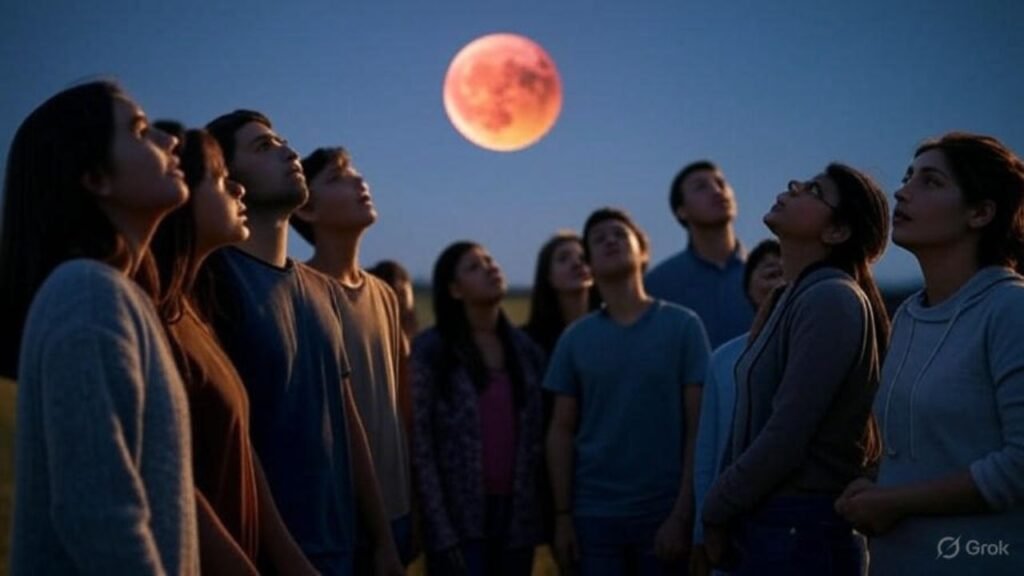Chandra Grahan – Chandra Grahan, popularly known as the Blood Moon, captivated skywatchers around the world as a rare total lunar eclipse unfolded over several hours. This celestial phenomenon occurs when the Earth comes directly between the Sun and the Moon, casting its shadow on the lunar surface and giving the Moon a distinctive reddish hue. Astronomy enthusiasts, photographers, and curious spectators gathered at observatories and open spaces to witness this breathtaking spectacle, making it a global event celebrated across continents. The Blood Moon’s deep red coloration is caused by Rayleigh scattering, where the Earth’s atmosphere filters sunlight, allowing only longer red wavelengths to reach the Moon. According to experts at Space.com, such total lunar eclipses are relatively uncommon, happening about twice a year, but each one varies in duration and visibility depending on geographic location. The Chandra Grahan this year offered a unique opportunity for observers in Asia, Africa, Europe, and parts of the Americas to witness the Moon in its full crimson glory. Enthusiasts documented the event using telescopes, cameras, and even smartphones, ensuring the spectacle was shared widely on social media. Scientists emphasize that observing lunar eclipses like this helps improve our understanding of Earth’s atmospheric conditions, while also inspiring wonder and curiosity in amateur astronomers. Events like the Blood Moon provide an ideal occasion for educational outreach and stargazing initiatives, bridging the gap between professional astronomy and public engagement. For those who missed it, experts at NASA provide detailed imagery and explanations to relive the mesmerizing experience from anywhere in the world.

Scientific Significance of the Blood Moon
The total lunar eclipse, or Blood Moon, holds immense scientific significance, offering researchers a natural laboratory to study both the Moon and Earth’s atmosphere. As the Earth casts its shadow across the Moon, variations in the red hue can reveal data about the concentration of dust and pollutants in our atmosphere. According to National Geographic, these observations allow climatologists and astronomers to track long-term changes in atmospheric composition. Moreover, lunar eclipses offer a unique chance to study the Moon’s surface without interference from direct sunlight, allowing researchers to measure subtle changes in temperature and light reflection. The interaction of sunlight with Earth’s atmosphere during an eclipse also provides clues about atmospheric refraction and scattering phenomena, critical for understanding global weather patterns. For astronomers, the Blood Moon serves as a calibration event for telescopes and imaging equipment, enhancing accuracy in observing distant celestial bodies. Public engagement in events like these also promotes STEM education, encouraging students and enthusiasts to participate in citizen science projects. Observatories worldwide often conduct live streaming sessions, educational webinars, and interactive discussions to explain the underlying science, making the Blood Moon both a visually stunning and intellectually enriching event. This rare lunar eclipse demonstrates how natural phenomena can unite scientific inquiry and public fascination, highlighting the importance of continuous observation and study of our celestial neighbors.
Global Visibility and Cultural Impact
The Blood Moon’s occurrence has far-reaching cultural and global significance, captivating not only scientists but also communities with rich astronomical traditions. In many cultures, lunar eclipses have historically been regarded as omens or mystical events, often inspiring festivals, rituals, and folklore. According to History.com, ancient civilizations such as the Babylonians and Chinese meticulously recorded eclipses, using them to predict celestial patterns and align religious observances. Today, the global visibility of the Chandra Grahan allowed millions of people from Asia, Europe, Africa, and the Americas to witness the spectacle, often sharing their experiences on social media platforms. The Blood Moon has also been integrated into modern pop culture, appearing in films, literature, and art, symbolizing transformation and awe. Cities and rural communities alike hosted public viewing events, offering telescopes and guided explanations to encourage collective participation. This widespread engagement fosters a shared sense of wonder and underscores humanity’s intrinsic connection to celestial phenomena. Moreover, international collaboration in tracking and documenting the eclipse highlights the unifying power of science, as observers from different countries coordinate measurements, photographs, and observations to contribute to a global understanding of the event. The Blood Moon thus transcends its scientific value, becoming a cultural and communal celebration of the universe’s mysteries.
Photography and Observation Tips
Capturing the Blood Moon requires careful preparation, timing, and the right equipment, making it a thrilling challenge for both amateur and professional photographers. Experts at Sky & Telescope suggest using a telescope or telephoto lens to achieve detailed images, while a tripod ensures stability during long exposure shots. The reddish hue of the Moon changes subtly throughout the eclipse, offering photographers opportunities to capture different stages of the phenomenon. Observers are advised to check local timings for maximum eclipse visibility to optimize both viewing and photography. Additionally, using smartphone cameras with clip-on lenses or advanced settings can yield impressive results, allowing enthusiasts to document the event for social media or educational purposes. Communities often organize workshops and tutorials in public parks and observatories, providing tips on exposure, focus, and framing to ensure the best possible images. Beyond photography, the experience of observing a Blood Moon firsthand is a memorable event, enhancing appreciation for the cosmos and fostering curiosity about astronomy. Whether through lenses or the naked eye, witnessing the Moon bathed in red light connects observers with a timeless celestial tradition that has inspired generations of stargazers.
Educational Opportunities and Future Lunar Eclipses
The Chandra Grahan serves as an invaluable educational opportunity, inspiring students, amateur astronomers, and educators to explore astronomy and space science in depth. Many schools and universities use total lunar eclipses as live classroom experiences, incorporating lessons on physics, orbital mechanics, and atmospheric science. According to Scientific American, observing lunar eclipses can enhance understanding of concepts such as light refraction, Rayleigh scattering, and celestial mechanics, making abstract scientific principles tangible. Online platforms and observatories also host virtual events, ensuring global accessibility to those unable to view the eclipse in person. Astronomical societies encourage participants to document their observations, contribute to citizen science projects, and engage in discussions with experts, thereby fostering a more interactive and participatory learning environment. Furthermore, information about upcoming lunar eclipses allows enthusiasts to plan future observations and comparisons, tracking changes in visibility and duration across different years. The Chandra Grahan not only captivates with its visual spectacle but also functions as a catalyst for education, exploration, and global collaboration, reminding humanity of our shared connection to the cosmos and the enduring mysteries of the night sky.








